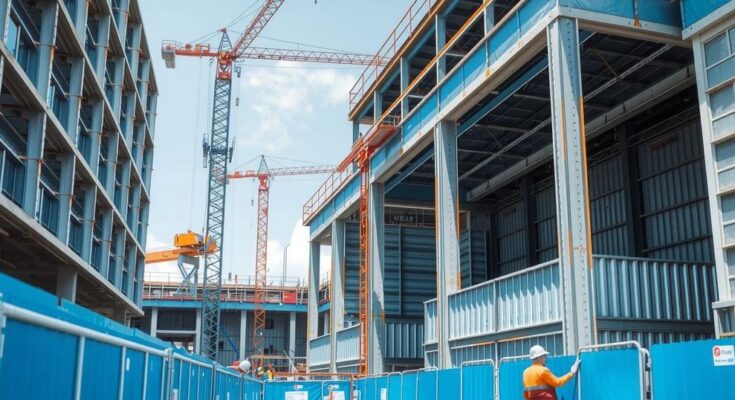The Mexican housing sector is bracing for a 3 to 4% increase in construction costs following U.S. tariffs on steel and aluminum. While investment has not halted, caution prevails among developers due to potential impacts on employment and purchasing power. Mexico faces a significant housing shortage, further exacerbated by these tariffs, despite government initiatives to build new homes.
The Mexican housing construction sector is anticipating a 3 to 4% cost increase due to 25% tariffs imposed by the United States on steel and aluminum imports. This announcement was made by the Mexican Chamber of the Construction Industry (CMIC), highlighting the financial challenges ahead for builders. Mexico, alongside Canada and Brazil, is a significant supplier of these materials to the U.S., which could exacerbate these costs if further tariffs are applied.
According to Carlos Eduardo Ramírez Capó, president of the National Chamber of the Housing Development and Promotion Industry (Canadevi), while investment in housing projects has not yet been hindered, precaution is being exercised by developers. Ramírez noted, “The damage will be directly proportional to the duration of the tariffs if it is imposed. If we have an escalation…there will be an impact.” This statement underscores the uncertainty facing the industry due to potential prolonged tariffs.
Rodrigo Padilla Quiroz, CEO of the Mexican Real Estate Bank (BIM), reported that no housing projects have been canceled as of now; however, developers are remaining vigilant. He expressed concern that the tariffs could negatively affect employment in the domestic construction sector, stating, “The biggest concern is a slowdown in [domestic] employment…it will affect Mexicans’ purchasing power.” This highlights the broader socio-economic implications of the tariffs beyond merely construction costs.
There is also an ongoing housing shortage in Mexico, estimated at nearly eight million homes. In 2024, only 128,147 homes were built, marking the lowest production level since the inception of the Single Housing Registry in 2013. Notably, 33.62% of these were low-income housing, priced at an average of 521,484 pesos (US $26,000), indicating a pressing need for affordable housing solutions.
Amid these challenges, President Claudia Sheinbaum has announced an ambitious plan to construct one million new homes nationwide over the next six years, with a budget allocation of 600 billion pesos (US $29.7 billion). This initiative aims to revitalize the housing sector and address the existing shortfall in housing.
Additionally, Mexico produced 18.2 million tonnes of steel in 2024, a decline from 19.85 million tonnes in 2023, primarily due to reduced demand. The export of steel amounted to three million tonnes in 2024, with a significant portion directed to the United States. Mexican steel manufacturers plan to boost production by over five million tonnes annually by 2026, though a sluggish domestic market could temper this growth as demand fluctuates.
In summary, the introduction of U.S. tariffs on steel and aluminum is projected to increase construction costs in Mexico, prompting caution among developers and raising concerns about employment and purchasing power in the construction sector. While the government embarks on plans to address the housing shortage, the steel industry faces challenges, including diminished demand and the need for increased production capacity. Such dynamics will significantly influence Mexico’s housing market in the coming years, highlighting the intertwined relationship between trade policies and domestic economic stability.
Original Source: mexiconewsdaily.com




